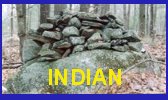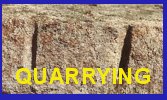



 |
 |
 |
 |
|
|
|
|
|
|
|
|
Osgood Graphite Mine, Nelson NH Site Report August 2002 By James Gage Introduction At the invitation of John Gilbert, Geologist, I performed a site walk of the Osgood Graphite Mine. I was asked to evaluate the industrial mining process / method that resulted in numerous triangular shaped drill holes in the rock. This evaluation included questions concerning how the holes were drilled, what type of tools were used, the advantages/disadvantages of triangular holes, and how the rock dust was removed from the holes. Location Nelson, New Hampshire Background John Gilbert had prepared a detailed historical / geological report of the graphite mines parts of which appeared in the Vol. 12 No. 1 (March 1995) Grapevine-2. The mine was operated from 1852 to 1865. The mine consisted of veins of graphite surrounded by “wall rock”. The wall rock was blasted and removed via haulage ways to one of four waste rock dumps. The mine has two main pits and three haulage ways used at different periods in the mine’s history. Findings The mine contains numerous examples of vertical drill holes on the wall faces. Most drill holes contain only a partial section of the original hole due to the effects of blasting. Several full length holes were observed near the top of a 60’ wall face and estimated to be a maximum of 5 feet in length. The bottoms of several drill holes were located with most of the bottom surface area intact. One of these examples yielded a single cut mark across the diameter of the hole. The triangular holes as seen from the top are an approximate equilateral triangle with extensive rounding of the corners. They consistently measured 2 inches from curved corner to curved corner. Measurements of the flat surface between curved corners produced values of between 1 ¾ inches and 1 7/8 inches. Measurements were taken from a small sample of partial drill holes seen on the rock face and from a single intact triangular hole of 14 inches length found in the waste dump.
Historical Evidence Two books make direct mention of triangular shaped holes. Both are worth quoting at length. Hammer Drilling. – The common weight of hammer for one-hand drilling is 4 ½ lbs; for two-hand or three-hand drilling 10 lbs. The striking face must be flat or slightly rounding, and smaller than the stock of the hammer. The hole is started on a solid and squared surface, with a short drill, for the longer the drill the less effective the blow. Light blows are struck at first. The bit is turned one-eighth of a revolution after each blow to insure keeping the hole truly circular. But in spite of this precaution most hand-drilled holes are three-cornered, or “rifled.” This rifling is not very objectionable in ordinary excavation work, but in quarrying square blocks for masonry it is decidedly objectionable because the rock tends to split in the directions of the three angles of the drill hole upon blasting. How to prevent this rifling will be shown in a subsequent paragraph. [pp.17] Source: Halbert Powers Gillette, Rock Excavation: Methods and Cost. New York, NY: M. C. Clark, 1904. … The hand borer was an iron rod with a steel, chisel-shaped cutting edge, held by one man who gave it a half turn in the hole between blows given by two men wielding sledge-hammers. After 20 minutes, they would change places. … To insure a round blast-hole, a steel collar was placed just behind the cutting edge at the bottom of the borer. Left alone, a borer made a triangular-shaped hole, which some Cornish quarrymen were said to have preferred. Despite twisting of the triangle, experienced men could judge the position of any of its faces at the bottom of the hole. The sides of the hole often determined the line of cracks made by the blast, but a problem arose of it was uncertain where the line of least resistance lay. [pp. 69-70] Source: Peter Stanier, South West Granite: A History of the Granite Industry in Cornwall and Devon. St Austell, Cornwall: Cornish Hillside Publications, 1999. Discussion Drill Tools & Techniques Three methods of hole drilling are documented prior to 1900: (1) various types of machine drilling, (2) Churn Drilling, and (3) Hammer Drilling. (1) Machine drilling produced round holes and required extensive support equipment including steam boilers or air compressors. No round holes were found at the site and no evidence was found for the presence of steam boilers or compressor machinery (no parts or the necessary supporting foundation work for the machinery.) (2) Churn Drilling was done with a long iron rod with a chisel at one end. Some churn drills called Ball Drills had a ball shaped weight welded in the middle of the rod. Ball drills were used for shorter holes were the weight of the rod itself was not sufficient for the drilling. The churn drill or ball drill was operated by one or more workmen who raised the drill and allowed it to drop back down the hole. The cutting was down by the weight of the drill upon impact with the rock. Churn drilling was considered more efficient than hammer drilling but required skilled labor. (Gillette, pp.13-14, 18-19) In Great Britain churn drills were referred to as swell jumpers and were the principle means of drilling holes prior to machine drilling. (Stanier pp. 75-76) However, in New England there is little evidence for churn drilling. Quarry photos generally depict hammer drilling. There are no references to churn drills producing triangular holes (3) Hammer Drilling is described in the above two quotes. Both quotes directly state that hammer drilling produces triangular shaped holes. The hammer drilling used drills of different lengths. The efficiency of the drill decreased with the length of the drill due the mass of the iron absorbing some of energy of the hammer blow. Short lengths were used to start the hole and longer lengths used as the depth of the hole progressed. In the case of the Osgood Graphite mine, the evidence indicates that a drill with a blade width of between 1 ¾ inches and 1 7/8 inches was used. Several other questions were raised during the site visit: (a) How was the rock dust removed from the holes? (b) Was water used during the drilling process? (c) If water was used how were the holes dried before the powder was inserted? (a) Various types of tools called “spoons”, “scrapers”, etc were used to remove rock dust from the holes. The instruments used for this purpose are called scrapers or dippers, and are usually very simple in construction. A common form is a strong wire having its ends bent at right angles and flattened so as to make a sort of scoop by which the drillings may be scraped or hoisted out of the holes. [pp. 20] Source: Charles Prelini, Tunneling: A Practical Treatise. 3rdedition. New York, NY: Van Nostrand and Co., 1905. A wooden rod, split or broomed at the end is often used for cleaning out a hole. The broomed end of the rod is dipped into the sludge, and when removed from the hole struck upon the rock to remove the sludge adhering to the broom end. [pp. 17] Source: Halbert Powers Gillette, Rock Excavation: Methods and Cost. New York, NY: M. C. Clark, 1904 (b) Water was used in the drilling process at some quarries. “In considering the effectiveness of vertical hole drilling it should be remembered that a hole which can be kept partly full of water can ordinarily be drilled faster than a dry hole …” (Gillette, 1904: pp. 16) (c) Quarrymen had simple means of drying holes prior to inserting black powder. “A spiral hook, or drag-twist, is also used for wiping the hole with hay before charging with black powder.” (Gillette, 1904: pp. 17) Blasting The extensive rock fracturing evidenced in the walls of the mine clearly indicated that the drill holes were used for blasting the waste or wall rock. The blasting was done using black powder. The triangular shape of the drill holes may have aided in establishing the direction of fracture from the blasting. According to Gillette, “the rock tends to split in the direction of the three angles of the drill hole upon blasting.” Stanier noted the same effect. Conclusion The physical and historical evidence supports the conclusion that the Osgood Graphite mine triangular drill holes were the product of hand boring using the “hammer drilling” method. The tools used to produce the drill holes included sledge hammers, a drill with iron shaft & rectangular steel cutting bit between 1 ¾” to 1 7/8” width, and some type of tool for removal of rock dust. There is a strong probability that the drilling was a two man operation: One workman holding and rotating the drill and a second workman using the sledge hammer. The purpose of the drill holes was to blast away the wall or waste rock from the graphite vein. There is a strong possibility that the points of the triangular shape holes were used to direct the line of fracture during the blast. |
|
|
|||||||||
 |
|||||||||
|
|
|||||||||
 |
|||||||||